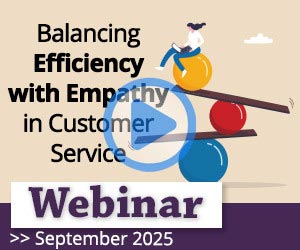Thomas Rødseth at Puzzel outlines five mistakes to avoid with customer journey mapping.
At first glance, customer journeys are pretty simple. You offer something and a customer buys it, but delve a little deeper and customer journeys can be quite complex.
Today, customers engage with your business in a multitude of ways and from many different starting points, for example, marketing, referrals, search, social media, customer service enquiries and above-the-line campaigns.
To deliver the best possible service, it makes sense to map out every touchpoint and create a visual representation of your customers’ experience from beginning to end.
However, in our complicated mobile-first, omnichannel, social-enabled world, it’s easy to fall into a few traps and make mistakes along the way.
Beware of the following pitfalls to guarantee no customer interaction slips through the cracks:
1. Ditch the ‘inside-out’ approach – it’s so easy to deliver customer service based on what works internally, often within the constraints of siloed departments or functional specialist knowledge. To gain real understanding of a customer’s journey, you have to turn the whole process on its head and view everything from the customer’s perspective.
Drink your own champagne! Try out some mystery shopping on your own company – call your helpline or initiate a webchat conversation and see for yourself what works and what doesn’t. When was the last time you sampled your own IVR? Introducing an ‘outside-in’ approach to customer journey mapping could be a revelation and even a wake-up call to kick-start different ways of working within your contact centre
2. Change the job spec – there was a time when team leaders were 100% focused on purely operational factors such as scheduling and performance metrics, and their agents relied on them for guidance on day-to-day activities. Seismic shifts in technology and consumer behaviour have changed all that.
Today, soft skills and technical knowledge are vital for success. When recruiting, organisations should look for managers who are change-oriented, forward thinking with a transformative vision and hire agents who share their ability to adapt, are technically literate and think strategically. Look at your own team – what training is required to bring your in-house skills up to date?
3. Don’t rely on quantitative surveys – contact centre agents represent the shop window to your organisation – why not encourage them to speak directly to customers to gain first-hand insight into their needs and aspirations rather than relying purely on anonymous and somewhat detached quantitative surveys?
You need to get your customers fully involved in the customer journey process. Ask them to comment on journey maps in a relaxed, live environment. Aim to run multiple sessions with as many different types of customers as possible in order to capture a fuller range of opinions. Then, once a common set of themes has been identified, go back to using quantitative multiple-choice-style surveys to sanity-check your proposed customer journey mapping
4. Don’t ignore the evidence – today’s clever technology, such as speech analytics and silent monitoring, makes it possible to capture the voice of the customer and better understand their needs. However, many organisations fail to follow up on this valuable source of business intelligence. It’s not just a tick-box exercise! What can you learn from individual customer interactions, good and bad, and what can be done to deliver the next best versions of your customer journey?
5. Never underestimate the impact of digital transformation – it’s a fact that today’s younger generation – tomorrow’s super-spenders – have a more favourable view of a brand or organisation if their customer service portal is mobile responsive, and those in the 18–34 age bracket are more likely to quit a brand through a poor service experience. What is more, it is this same millennial generation that turns to social media when they are not happy, with 47% of 18–34-year-olds admitting to using social media to complain compared with 12% in the 55+ age group!

Thomas Rødseth
It’s time to nurture this growing consumer segment who want and expect to shop in a mobile, self-serve environment. Take a look at your offering on a smartphone or tablet – is it mobile responsive and are there features that accelerate and enhance the overall experience, such as click to call for assistance?
Breathe, count to ten and take a measured approach to customer journey mapping and avoid falling into the same old traps. Let your contact centre become the engine room of great customer service and, in so doing, add real strategic value to your organisation’s business performance.
With thanks to Thomas Rødseth, VP of Product & Marketing at Puzzel. Find out more by visiting www.puzzel.com
Author: Rachael Trickey
Published On: 21st Sep 2017
Read more about - Archived Content, Puzzel





























